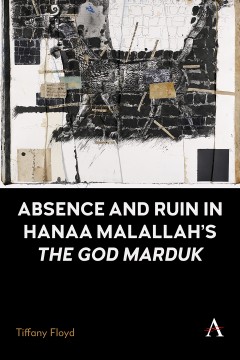Absence and Ruin In Hanaa Malallah's 'The God Marduk'
By Tiffany Floyd
Anthem Modern and Contemporary Art of the Arab World, Iran and Turkey
Other Formats Available:
- About This Book
- Reviews
- Author Information
- Series
- Table of Contents
- Links
- Podcasts
About This Book
This book offers an in-depth analysis and contextualization of Hanaa Malallah's art book The God Marduk, published in 2008. Currently housed in storage at the British Museum, Malallah's art book is not only a poignant manifestation of the artist's signature 'Ruins Technique' but also a document that responds to a critical contextual moment wherein Iraqi artists looked back upon and continued to grapple with the cultural ruins of their nation. The artbook itself is a complex configuration of materials, narratives and formal arrangements that speak of both meticulous construction and expressive release. Bound on both sides, the book is constructed with a non-linear, multidirectional rhythm holding folios of various sizes, cuts, patterns, texts and images. Extra materials are placed into pockets multiplying the modes of interface while several pages are punctured and torn to allow one page to meld into the next. Opening outwards on either side, the pages form a range of conceivable permutations so that it is possible to open the book differently with each viewing. Malallah's book cannot thus be 'read' by flipping pages in a prescribed sequence, but through the motions of unfurling, unfolding and uncovering. These actions reveal (and conceal) an ever-expanding (and contracting) centralized tableau of the God Marduk's dragon, a composite creature always in flux. As a multifaceted object document, Malallah's art book acts as a prism refracting various strands of her personal artistic journey and that of her peers.
HanaaMalallah belongs to the 'Eighties Generation' of Iraqi artists, those who were educated in Baghdad during the 1980s and remained in the country during the sanctions of the 1990s through the US-led invasion of 2003. During this time, members of the 'Eighties Generation' continued to produce artwork despite the uncertainties of war as not only a cathartic release and mode of expressing trauma but also as a means of understanding new artistic realities necessitated by isolation and insecurity. Along with the relative dearth of scholarly material on Iraqi modern and contemporary art –the notable work of Nada Shabout, Elizabeth Rauh, Sarah Johnson and Saleem al-Bahloly notwithstanding – this 30-year period (between the last two decades of the twentieth century and the first decade of the twenty-first) has yet to be fully theorized as a time of transition whereby the narratives of Iraqi modernity give way to a new sensibility, what might be called Iraqi contemporary art. This book seeks to understand this period of transition through Malallah's work The God Marduk. I argue that this artbook carries within it both the problems of the past and the promises of the future through a process of internalizing an archeological vision of making –a mode that is both destructive and reconstructive.
This study begins by contextualizing Malallah'sThe God Marduk considering the artistic trajectories of the 'Eighties Generation' within the historical circumstances of Iraq during the 1980s and 1990s. It then moves to a more specific investigation of Malallah's practice, focusing specifically on her use of the ancient past as a conduit for aesthetic and emotive expression. The next two chapters offer an in-depth visual analysis and art historical interpretation of The God Marduk, primarily through the method of phenomenology (the experience of 'reading' and handling the book). Finally, the book reflects on Iraqi art in the post-2003 period using Malallah's practice generally and The God Marduk specifically as departure points to discuss ways that artists are moving forward in the diaspora, but also working to rebuild a thriving contemporary art scene in Iraq.
Reviews
Author Information
Tiffany Floyd received her PhD in Art History from Columbia University with a dissertation centered on modern and contemporary art in Iraq. She is currently an adjunct faculty member of the Department of Art History at the University of North Texas.
Series
Anthem Modern and Contemporary Art of the Arab World, Iran and Turkey
Table of Contents
Links
Stay Updated
Information
Latest Tweets



